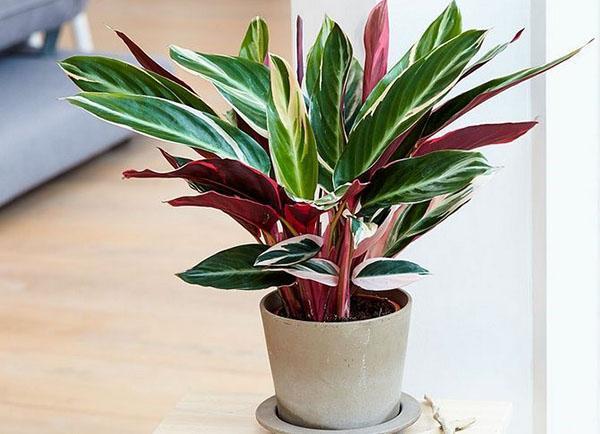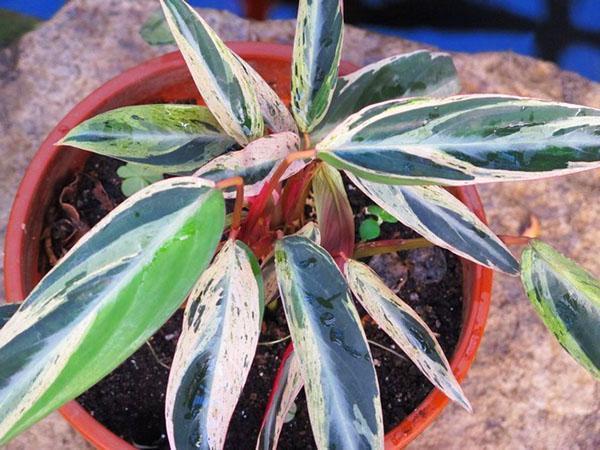Features of growing stromant in room conditions
 Many growers prefer such an unusual plant as stromant, the cultivation of which has certain difficulties. Knowing about all the secrets and nuances of caring for an exotic flower, you can create conditions that allow it to show itself in all its glory. Stromant - a great option when you want to add a little exotic to the interior. Large leaves are striking due to their original color in the form of contrasting spots, stripes scattered over a dark green background. Such beauty will not leave anyone indifferent.
Many growers prefer such an unusual plant as stromant, the cultivation of which has certain difficulties. Knowing about all the secrets and nuances of caring for an exotic flower, you can create conditions that allow it to show itself in all its glory. Stromant - a great option when you want to add a little exotic to the interior. Large leaves are striking due to their original color in the form of contrasting spots, stripes scattered over a dark green background. Such beauty will not leave anyone indifferent.
Choosing a place for a flower

If you have to place a pot of stromant on the south window, you need to curtain it with a curtain made of translucent fabric.
The plant is very sensitive to temperature extremes, so a place for it is chosen away from drafts.
Even with the most careful care, flowering of stromant at home is extremely rare.
Growing conditions
 Stromanta is a capricious plant. A plant accustomed in nature to a tropical climate needs to create similar conditions when growing in an apartment. Competent care involves following a number of rules.
Stromanta is a capricious plant. A plant accustomed in nature to a tropical climate needs to create similar conditions when growing in an apartment. Competent care involves following a number of rules.
Watering
The moisture content of the soil for stromant is of great importance. In summer and spring, when the green mass is actively growing, it is required to make abundant watering almost daily. In winter, the plant is watered less often, waiting for the substrate to dry out. For this, water should be used only settled or distilled, at room temperature.
Waterlogging of the soil, as well as overdrying, can lead to the death of the plant.
Air humidification
In addition to watering, the stromant needs daily spraying of the leaves with water. In hot weather, this is done up to several times a day. In winter, when the air becomes especially dry as a result of the operation of heating systems, it is recommended to humidify it in various ways: place containers with water next to the flower, install special air humidifiers.
Do not spray the plant during the day, in the bright light of the sun, to prevent burns.
Temperature regime
Heat is one of the most important conditions for keeping stromant. Its optimal indicators during the growing season are from 22 to 30⁰С. At higher temperatures, the humidity level should also be increased. In winter, the temperature is reduced to 18-22⁰С. It is important that it does not fall below 15⁰С. In such conditions, the aerial part of the flower dies.
Top dressing
The cultivation of stromant is not complete without the use of fertilizers. Top dressing is carried out depending on the season. In spring and summer, liquid is used twice a month. complex fertilizer for ornamental plants.The soil is preliminarily moistened, after which it is spilled with the prepared solution. Occasionally, foliar dressing can be carried out by spraying the plant from a spray bottle with fertilizer diluted in a half dose. In winter, during the dormant period, it is not necessary to fertilize the stromant.
Transplant features
 As for any houseplant, home care for stromant implies periodic replanting. In the first 4 years of a plant's life, this procedure is carried out annually, then every 2 years. The pot is selected slightly higher than the previous one. With a layer of 5 cm, drainage is poured onto the bottom. Prepare the soil mixture in advance. To do this, mix leafy earth, peat and river sand in a 2: 1: 1 ratio and add a little charcoal. It has the ability to absorb excess moisture in the substrate, and when the soil dries up, return it back.
As for any houseplant, home care for stromant implies periodic replanting. In the first 4 years of a plant's life, this procedure is carried out annually, then every 2 years. The pot is selected slightly higher than the previous one. With a layer of 5 cm, drainage is poured onto the bottom. Prepare the soil mixture in advance. To do this, mix leafy earth, peat and river sand in a 2: 1: 1 ratio and add a little charcoal. It has the ability to absorb excess moisture in the substrate, and when the soil dries up, return it back.
You can increase the moisture capacity and looseness of the substrate by adding sphagnum moss to it.
The stromant is transplanted into a previously disinfected soil. It is steamed for 15 minutes in a water bath, then sprinkled on a newspaper sheet to dry.
 The stromanthus is taken out of the pot in such a way as not to damage the root system. Having carefully shaken off the old soil, the plant is lowered into a prepared container with drainage and the substrate is added. After transplanting, the soil is poured abundantly, filling up the settled soil.
The stromanthus is taken out of the pot in such a way as not to damage the root system. Having carefully shaken off the old soil, the plant is lowered into a prepared container with drainage and the substrate is added. After transplanting, the soil is poured abundantly, filling up the settled soil.
Reproduction
 At home, 2 methods of propagation are used - cuttings and division of the rhizome. In the first case, the cut branches are placed in a container with peat, covered with a plastic bag on top to create greenhouse conditions. Rooted cuttings are transplanted into small pots with a nutrient mixture.
At home, 2 methods of propagation are used - cuttings and division of the rhizome. In the first case, the cut branches are placed in a container with peat, covered with a plastic bag on top to create greenhouse conditions. Rooted cuttings are transplanted into small pots with a nutrient mixture.
Reproduction of stromant by dividing the rhizome is carried out only when transplanting adult plants. The root is divided into 2-3 parts, each being planted in a separate container.